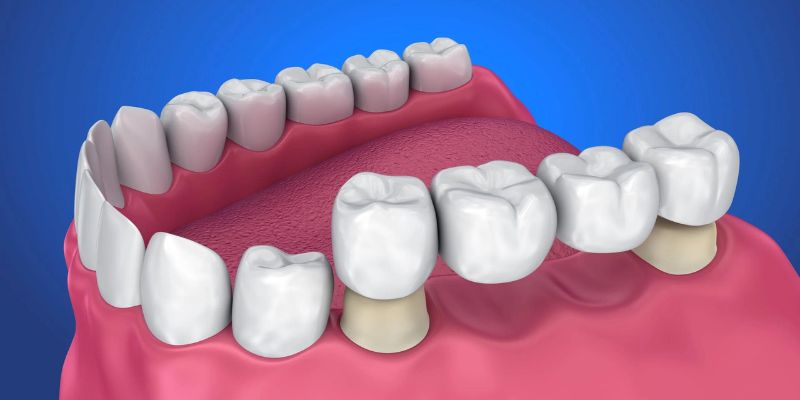What Is a Dental Bridge
Jan 30, 2024 By Madison Evans
Have you ever wondered what a dental bridge is? Do you need to know more about this restoration tooth replacement solution? If so, then you have come to the right place.
In this blog, we will explore the basics of dental bridges and how they work and provide insight into why this may be the ideal solution for your missing teeth needs.
From learning what types of bridges are available to understanding when it may be time to seek out a professional for your dental care, by the end of this blog post, you will feel confident about how dental bridges can help restore your pretty smile!
So without further ado, let's jump in and learn all there is to know about installing a bridge!
What Is a Dental Bridge and How It Works

A dental bridge is a restoration tooth replacement solution that uses a false tooth, known as a pontic, to fill the gap left by one or more missing teeth. The pontic is attached to two crowns (abutments) that connect it to adjacent teeth on either side of the space.
By connecting these three pieces, the dental bridge is securely held in place, restoring the look and function of your smile.
The type of dental bridge you receive will depend on where your missing teeth are in your mouth and what kind of restoration materials you and your dentist choose to use.
Depending on these factors, a traditional bridge may be the ideal solution for smaller gaps, or a cantilever bridge may be preferred.
In addition, different materials such as porcelain or metal can also provide aesthetic and structural advantages to your restoration.
What happens during a dental bridge procedure?

The dental bridge procedure will typically occur over two or more visits to your dentist.
During the first visit, your dentist will prepare the abutment teeth by removing a portion of the enamel from them and fitting them with crowns.
Then, impressions of the prepared area are taken and sent to a laboratory where the false tooth (pontic) is produced.
During the second visit, your dentist will check the fit of the pontic and secure it in place with dental cement.
Why do I need a dental bridge?
If you're missing one or more teeth, a dental bridge may be the ideal solution to restore your smile. A bridge helps improve the appearance and function of your mouth by closing the gap left by a missing tooth.
Filling in this space also prevents nearby teeth from shifting out of alignment, which can lead to further complications such as gum disease or temporomandibular joint (TMJ) disorder.
In addition to providing cosmetic and functional benefits, a dental bridge can help preserve your bite force by replacing the missing tooth's chewing surface.
This helps you chew food more effectively and prevents other teeth from compensating for the lost tooth, leading to further wear and tear on the remaining teeth.
Types of dental bridges
• Traditional bridges
This type of bridge comprises a pontic tooth connected to two abutment teeth, supported by dental crowns. They are typically used in areas with only one missing tooth.
• Cantilever bridges
These bridges use just one abutment tooth to support the pontic tooth and are often used when the gap is larger than a traditional bridge.
• Maryland bridges
This type of bridge uses metal or porcelain "wings" to hold the pontic in place and is usually used when replacing front teeth.
Benefits of Getting a Dental Bridge
• Improved Function
One of the most important benefits of a dental bridge is that it can restore the function of your teeth.
The pontic tooth is an anchor for your other teeth, preventing them from shifting out of place and causing misalignment or bite problems.
• Improved Aesthetics
Replacing missing teeth with a dental bridge also helps improve your smile's appearance. The pontic tooth looks and functions like any other natural tooth, so you can feel confident showing off your restored smile.
• Improved Oral Health
With a dental bridge, you won't have to worry about bacteria and food particles accumulating in the gap left by missing teeth. This helps to reduce your risk for cavities, gum disease, and other oral health issues.
Preparation for Getting a Dental Bridge
• Scheduling a Consultation
The first step in getting a dental bridge is to schedule an appointment with your dentist. During this appointment, they will examine your teeth and ensure that a bridge is your best solution.
• Preparing the Abutment Teeth
Once it's determined that a bridge is the right choice for you, your dentist will prepare the Abutment teeth by removing a portion of the enamel from them and fitting them with crowns.
• Taking an Impression
Next, your dentist will take an impression of the prepared area and send it to a laboratory where the false tooth (pontic) is produced.
• Fitting the Pontic Tooth
At your next appointment, your dentist will check the fit of the pontic tooth and secure it in place with dental cement.
What happens during a dental bridge procedure?
The dental bridge procedure will typically occur over two or more visits to your dentist. During the first visit, your dentist will prepare the abutment teeth by removing a portion of the enamel from them and fitting them with crowns.
Then, impressions of the prepared area are taken and sent to a laboratory where the false tooth (pontic) is produced. During the second visit, your dentist will check the fit of the pontic and secure it in place with dental cement.
When is it time to seek out a professional for dental care?
Cost of Getting a Dental Bridge
The cost of getting a dental bridge will vary depending on several factors, such as the type of bridge you receive and the materials used.
Generally speaking, traditional bridges are more affordable than cantilever or Maryland bridges.
In addition, porcelain is typically more expensive than metal. Your dentist will be able to estimate what your treatment may cost after your initial consultation.
Risks Involved With Getting a Dental Bridge
• Tooth Sensitivity: After getting a dental bridge, the abutment teeth may become sensitive to temperature and pressure. This is normal and should dissipate over time.
• Decay: If the abutment teeth are not properly taken care of, they may be at risk for decay or infection. Practicing good oral hygiene and visiting your dentist regularly is important to prevent this.
• Fracture: While rare, bridges can sometimes fracture or come loose due to trauma or excessive wear and tear. Avoid chewing hard foods and objects with your bridge is important to reduce this risk.
FAQs
How long does a tooth bridge last?
A well-crafted and properly maintained dental bridge can last several years, even a lifetime. With regular checkups and professional maintenance, your dentist will be able to ensure that your bridge remains in good condition and is functioning optimally.
Is getting a dental bridge painful?
No, getting a dental bridge should not cause any pain. If you are anxious about the procedure, many sedation dentistry options are available to help put you at ease during your appointment. Your dentist will also provide detailed instructions on caring for your bridge and keeping it looking its best.
What is better, a bridge or an implant?
This individualized decision depends on the patient's unique needs and budget. A bridge uses an adjacent tooth to hold it in place, while an implant requires no other anchors and offers a more permanent solution. Your dentist can provide you with recommendations based on your specific circumstances.
Conclusion
Dental bridges provide a great way to restore your smile while enhancing eating and speaking functionality.
These restorative solutions offer many benefits, from traditional dental bridges to implant-supported alternatives.
If you are considering replacing missing teeth with a dental bridge, speaking with an experienced professional about your options is important.
Your dentist can help you determine the best solution for your individual needs. With the right bridge, you can restore your smile and enjoy greater oral health for years!
On this page
What Is a Dental Bridge and How It Works What happens during a dental bridge procedure? Why do I need a dental bridge? Types of dental bridges • Traditional bridges • Cantilever bridges • Maryland bridges Benefits of Getting a Dental Bridge • Improved Function • Improved Aesthetics • Improved Oral Health Preparation for Getting a Dental Bridge • Scheduling a Consultation • Preparing the Abutment Teeth • Taking an Impression • Fitting the Pontic Tooth What happens during a dental bridge procedure? Cost of Getting a Dental Bridge Risks Involved With Getting a Dental Bridge FAQs How long does a tooth bridge last? Is getting a dental bridge painful? What is better, a bridge or an implant? Conclusion
Reason Improving Sleep Can Prevent Migraine Attacks

Exploring the Link Between Psoriasis and Cancer: New Study Insights

Understanding Fat Storage and Energy Conversion in the Human Body

The Ultimate Guide to the Best Cardio Workouts for Weight Loss

Forehead Pimples? 5 Reasons Why They Keep Appearing

A Manual to Deal With Psychological Projection

A Comparative Guide: Choosing Between Olive Oil and Coconut Oil in the Kitchen

Folic Acid: A Complete Guide

A Comprehensive Guide to Dealing With a Pinched Nerve

Understanding 5 Different Pathways To Recovery

Reflection: The Role of Reflective Practice in Healthcare Professions
